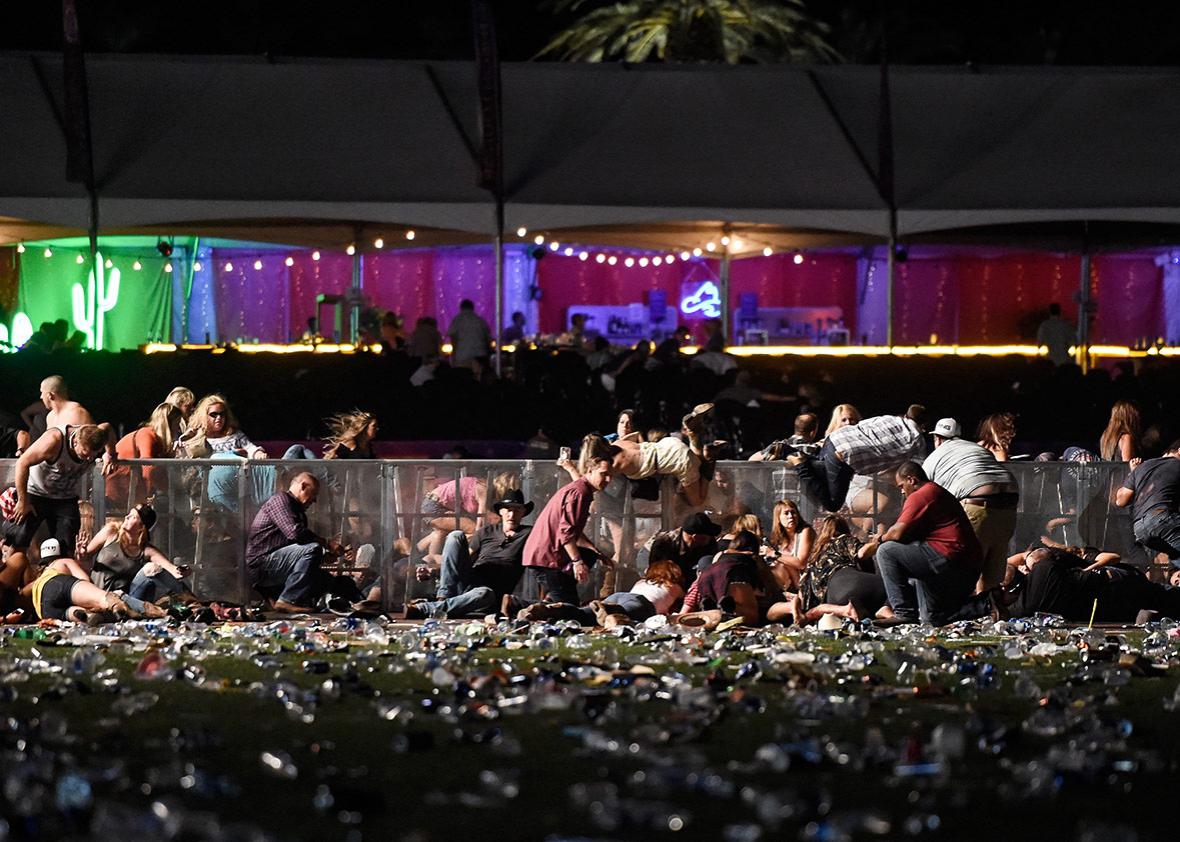The National Rifle Association claims to represent law-abiding citizens. Its leaders say they oppose new gun laws not for the sake of anarchy or the firearms industry, but for the “good guys” who just want to hunt, go target-shooting, and protect their families. There’s a simple way to test this claim. Some weapons, designed for speed and carnage rather than accuracy, lend themselves to use by bad guys, not good guys. Does the NRA support legislation against these weapons? No. It defends them.
Mass shooters love high-capacity magazines. In recent attacks, they’ve used magazines that held 30 rounds (Newtown, Connecticut, in 2012), 33 rounds (Tucson, Arizona, in 2011), 40 to 100 rounds (Aurora, Colorado, in 2012), and 60 to 100 rounds (Las Vegas earlier this month). If you’re firing indiscriminately into a crowd—and if you brought lots of weapons with you, in case the first one jams—big magazines are handy.
But if you’re trying to hunt, hit a range target, or aim at a bad guy without hurting bystanders, big magazines are worse than useless. Don’t take it from me. Take it from one of the world’s biggest pro-gun websites, the Truth About Guns. According to the site’s founder, Robert Farago, oversized magazines like the one used in Aurora weigh down your weapon and warp your posture, impairing your aim. Another Second Amendment advocate, academic expert Dave Kopel, has testified that magazines that hold 11 to 19 rounds are useful to cops and citizens but 100-round drums aren’t.
The NRA doesn’t care. In a Fox News interview after Newtown, NRA CEO Wayne LaPierre was shown video of parents explaining that 11 kids had survived the attack by running away when the shooter paused to reload. LaPierre shrugged it off, insisting that a limit on magazine size wouldn’t have helped. He argued that homeowners might need high-capacity magazines to fend off intruders. But even if they didn’t, he said a magazine limit would oppress “law-abiding people” by “making the law books thicker.” This week on Fox News Sunday, Chris Cox, the executive director of the NRA’s Institute for Legislative Action, was asked why anyone would need 100-round magazines like those used by Stephen Paddock in Las Vegas. “People own magazines of different capacities for different reasons,” Cox replied. But he couldn’t name a good reason.
Paddock also used bump stocks, which, as we’ve learned, multiply a gun’s rate of fire. Unlike forward grips—which, as Kopel has explained, improve accuracy by stabilizing a rifle—bump stocks destabilize the weapon, causing it to fire by recoil rather than by deliberate trigger pulls. In field tests, you can watch how this impedes aim. Honest firearms enthusiasts acknowledge that bump stocks have “no legitimate purpose” and “don’t add anything to a citizen’s ability to use a rifle in defense of herself or our nation.” Bump stocks were useful to Paddock, they point out, only because he “was shooting indiscriminately at an enormous target.”
The NRA has a clever response to all that. It says the Bureau of Alcohol, Tobacco, Firearms, and Explosives should assess whether current restrictions on fully automatic weapons—those that fire continuously with a single pull of the trigger—ought to apply to bump stocks, which mimic automatic fire. This response leaves the impression that the NRA thinks bad-guy weapons—those that favor speed over accuracy—should be treated differently from good-guy weapons. But that impression is a sham. According to Cox and LaPierre, the NRA doesn’t endorse a ban on bump stocks and doesn’t want Congress to touch the issue. When Cox was asked about bump stocks on Fox News Sunday, he said that bans never work and that focusing on “devices” of any kind was a distraction.
The bigger story is that the NRA has never made peace with laws against fully automatic weapons. These weapons, which trade stability for rapid fire, are the classic bad-guy device. “In civilian hands a machine gun is pretty much useless,” writes Nick Leghorn, an editor at the Truth About Guns. It’s “too inaccurate to be used for hunting” and “of questionable benefit in home defense scenarios.” But machine guns were popular among gangsters a century ago, and that’s why, in 1934, Congress sharply restricted their availability. The purpose of that law, another pro-gun writer explains, was “to limit the ability of a single civilian to inflict mass casualties.”
In 1986, Congress renewed the law against machine guns. The NRA accepted this as part of a gun rights package, but only temporarily. “Repealing the machine gun amendment … will be a high priority,” said LaPierre, who ran the NRA’s legislative institute at the time. The NRA pledged to defend “the right of law-abiding individuals to choose to own any firearm, including automatic firearms.” For years, it fought the machine gun law in court. Twenty-five years later, the NRA continued to portray it as an unfortunate political compromise. As a matter of regulatory interpretation, the NRA now says machine gun restrictions can apply to bump stocks. But as a matter of principle and legislation, the NRA doesn’t really accept those restrictions.
A few days ago on Face the Nation, John Dickerson asked LaPierre about machine guns. “We have supported the existing law on fully automatic firearms,” LaPierre replied. That’s a cagey answer. It’s a narration, not a commitment. If bans were effective, LaPierre added, the 2015 attack in Paris, which relied in part on automatic weapons, “would not have happened. They outlaw fully automatic guns.” Cox, in his Fox News interview, leveled the same criticism at European laws against machine guns. Clearly these men believe that bans on machine guns, like bans on bump stocks and other devices, are futile.
The NRA doesn’t distinguish between good and bad weapons. It opposes restrictions of any kind. No matter how well a firearm or accessory is designed for mayhem rather than self-defense, the NRA won’t agree that it should be outlawed. That’s the difference between an organization that defends people and an organization that defends guns.
